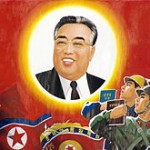 Reporters have had a field day in recent weeks as stories trickling out of North Korea have shed new light into the country. This has included the emergence of a first lady, images of western themed concerts, amusement parks, short skirts, and a far more open and seemingly personable leader. However these stories have tended to miss the mark in their eagerness to report shifts in policy under the new DPRK leader, Kim Jong Un.
Reporters have had a field day in recent weeks as stories trickling out of North Korea have shed new light into the country. This has included the emergence of a first lady, images of western themed concerts, amusement parks, short skirts, and a far more open and seemingly personable leader. However these stories have tended to miss the mark in their eagerness to report shifts in policy under the new DPRK leader, Kim Jong Un.
North Korean opposition to opening up its borders, renouncing the old ways, and drastically reforming its social and economic structure is as steadfast as ever. DPRK leaders are still preoccupied with the survival of the DPRK regime-the forefront goal of the leadership since its inception.
This largely falls in line with 2012 being the year of “Gangsong Daeguk” or ‘strong and prosperous great nation’- ie the year North Korea will finally ascend to the lofty economic and military heights it so often projects itself as having achieved.
As Chung-in Moon and John Delury have noted “If Kim Jong-il could claim nothing else’, ‘he did achieve at least one thing for North Korea — the ultimate”strength” of nuclear deterrence’. While the North’s recent missile test may have failed, the DPRK has still been able to fall back on the nuclear card as a signal of its military might, achieving half of Gangsong Daeguk. However the economic side has been left wanting.
There was never any hope of a quick economic recovery by 2012, especially with serious droughts plaguing the peninsula and the withdrawal of U.S. food aid after of the North’s tests. Additionally undertaking the reforms required for economic prosperity would undermine the legitimacy of the DPRK regime – or force the DPRK to sacrifice its nuclear program.
Kim Jong Un has thus been left in a difficult position. Having proclaimed/emphasized Gangsong Daeguk, Kim must provide some notion of domestic advancement while maintaining the integrity of the DPRK leadership. And so we turn to the “odd” stories floating out of the North.
Under Kim Jong Il the people of North Korea became used to a distant, stern and somber leader, a solitary pillar suited to guide North Korea through its times of trouble.
Accordingly Kim Jong Un has sought to portray the image of a bright and shining leader who represents Gangsong Daeguk. What better way to do this than to become the embodiment of the quintessential “family man” of the new Korea- modern, warm, and embracing-the father of happy flourishing family.
In a stark contrast to Kim Jong Il, he has shown himself as the happy, all-embracing family man, introducing his wife to the public, and often seen smiling and hugging his “children” of the nation.
Where there was once strictly regulated clothing and entertainment, there are now elements of the modern world-symbols of North Korean progress. Western images portrayed by the DPRK regime could also be seen as an attempt to minimize the impact of illegal DVDs and electronic devices smuggled in from China.
By carefully orchestrating the “appropriate introduction” of at least some of these cultural phenomena-i.e. Disney characters or clothing styles- Kim can hijack their impact for his own cause by displaying them as signs of homegrown North Korean domestic progress.
This does not mean that North Korea will soon embrace western culture and ideology. The clothing, performances, and other abnormalities have become a calculated maneuver to display Gangsong Daeguk while at the same time regulating cultural advances by making them distinctively Korean-ie part of the DPRK propaganda machine. In turn they will continue to be closely regulated and utilized simply as a PR ploy. Accordingly one should not expect to witness any sort of drastic changes within the DPRK any time soon.


